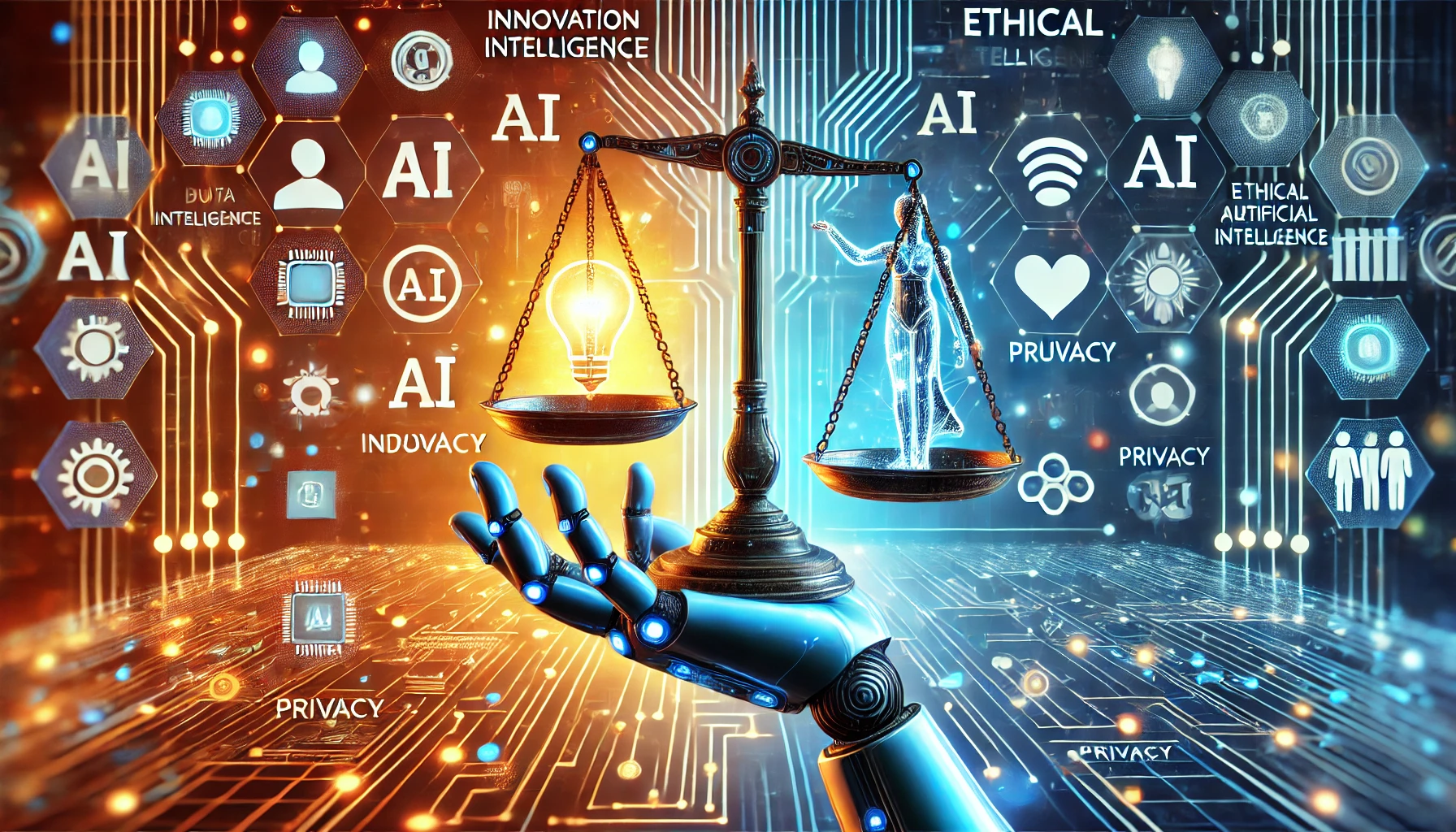In 2024, Artificial Intelligence (AI) is a cornerstone of innovation, driving advancements in healthcare, cybersecurity, and more, with a global market value of $184 billion (Statista, 2024). Yet, its rapid adoption has sparked ethical concerns—bias, privacy violations, and societal impacts—demanding a delicate balance between innovation and responsibility. As AI reshapes industries and daily life, navigating its ethical landscape is critical. This article explores the key ethical challenges of AI in 2024, strategies to address them, and the importance of responsible AI development to ensure a future where technology benefits all.
The Ethical Imperative of AI in 2024
AI’s transformative potential is undeniable, contributing $3.5 trillion to global GDP in 2024 (McKinsey, 2024). However, its ability to process 79 zettabytes of data annually (TechMagic, 2024) raises ethical questions. From biased algorithms to surveillance risks, AI’s misuse can amplify inequalities and erode trust. In 2024, 70% of consumers express concerns about AI-driven data privacy (Pew Research, 2024), while 60% of organizations lack robust AI governance (Forrester, 2024). Balancing innovation with ethical responsibility is essential to harness AI’s benefits while mitigating harm.
Key Ethical Challenges in AI
1. Bias and Fairness
AI systems trained on biased data can perpetuate discrimination. In 2024, 30% of facial recognition tools misidentify minorities, leading to unfair outcomes in hiring or law enforcement (ScienceDirect, 2024). For example, Amazon’s scrapped AI recruitment tool in 2018 favored men due to biased training data, a lesson still relevant. Bias not only undermines fairness but also risks legal repercussions, with fines under the EU’s AI Act reaching €35 million (Deloitte, 2024).
- Impact: Biased AI erodes trust, with 65% of consumers avoiding brands using unfair algorithms (Edelman, 2024).
2. Privacy and Data Security
AI’s reliance on vast datasets fuels privacy concerns. In 2024, 75% of breaches involve personal data misuse, costing $4.5 million per incident (IBM, 2024). Generative AI tools, like those powering chatbots, risk leaking sensitive information if improperly trained. Regulations like GDPR and CCPA impose strict guidelines, yet 40% of firms struggle with compliance (Check Point, 2024).
- Impact: Privacy violations reduce consumer confidence, with 80% demanding transparency in AI data use (Pew Research, 2024).
3. Accountability and Transparency
AI’s “black box” nature—where decision-making processes are opaque—complicates accountability. In 2024, only 25% of AI systems provide explainable outputs, hindering trust and regulatory compliance (Gartner, 2024). For instance, healthcare AI misdiagnoses without clear reasoning can endanger lives, with 20% of AI medical tools lacking transparency (Nature, 2024).
- Impact: Lack of explainability delays AI adoption in high-stakes sectors like finance and healthcare.
4. Job Displacement and Inequality
AI’s automation of 30% of jobs in 2024 (McKinsey, 2024) raises ethical questions about workforce displacement. Low-skill workers face higher risks, with 25% struggling to retrain (OECD, 2024). This exacerbates inequality, as high-skill AI roles, like data scientists ($130,000/year, Glassdoor, 2024), benefit a small elite.
- Impact: Uneven job impacts fuel social unrest, with 50% of workers fearing AI-driven unemployment (Gallup, 2024).
Strategies for Responsible AI Development
To navigate these challenges, organizations and policymakers are adopting strategies to ensure ethical AI:
1. Bias Mitigation
Diverse, high-quality datasets and regular audits reduce bias. In 2024, tools like IBM’s AI Fairness 360 detect and correct bias, improving fairness by 35% (IBM, 2024). Inclusive development teams, with 50% more diverse representation, also minimize unintended biases (McKinsey, 2024).
- Example: Google’s AI Principles prioritize bias testing, enhancing fairness in search algorithms (Google, 2024).
2. Privacy by Design
Embedding privacy into AI systems ensures compliance and trust. Techniques like federated learning, used by Apple, process data locally, reducing exposure (Apple, 2024). Anonymization and encryption protect user data, with 60% of firms adopting these in 2024 (Forrester, 2024).
- Example: Microsoft’s Azure Confidential Computing safeguards data during AI processing (Microsoft, 2024).
3. Explainable AI (XAI)
XAI tools make AI decisions transparent, fostering trust. In 2024, DARPA’s XAI program improved explainability in 40% of tested models (DARPA, 2024). Regulatory frameworks, like the EU’s AI Act, mandate explainability for high-risk applications, driving adoption.
- Example: Salesforce’s Einstein Analytics explains customer predictions, aiding compliance (Salesforce, 2024).
4. Workforce Reskilling
Addressing job displacement requires upskilling. In 2024, 2 million workers accessed AI training via platforms like Coursera and AWS, with 70% reporting career advancement (AWS, 2024). Public-private partnerships, like India’s Skill India, aim to train 400 million by 2030 (NITI Aayog, 2024).
- Example: Amazon’s Upskilling 2025 program trained 100,000 employees in AI skills (Amazon, 2024).
The Role of Regulation and Collaboration
In 2024, global regulations shaped AI ethics. The EU’s AI Act categorized AI by risk, imposing strict rules on high-risk systems, while the U.S. introduced NIST’s AI Risk Management Framework, adopted by 50% of tech firms (NIST, 2024). Collaborative efforts, like the Global Partnership on AI, fostered ethical standards across 20 nations (GPAI, 2024). X discussions, with #AIEthics trending, amplified public and expert voices, pushing for accountability.
Challenges in Balancing Innovation and Ethics
Striking a balance is complex. Overregulation risks stifling innovation, with 40% of startups citing compliance costs as barriers (Crunchbase, 2024). Conversely, lax oversight fuels misuse, as seen in 30% of AI-driven cyberattacks using deepfakes (Synoptek, 2024). Skill gaps also hinder ethical AI adoption, with 45% of firms lacking expertise (TechMagic, 2024). Continuous education and agile governance are critical to align innovation with responsibility.
